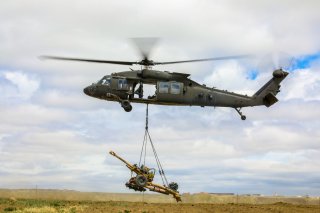The Defiant X Assault Helicopter Will Take the Army to New Heights
The Defiant’s ability to deliver weapons at high speeds and altitudes greatly improves operational prospects.
The U.S. Army is fast-tracking its Future Vertical Lift (FVL) program in order to develop a new generation of rugged rotorcraft technology with double the range and speed of existing helicopters.
Lt. Gen. Ben Hodges (ret.), former commanding general of U.S. Army Europe, succinctly captured the essential role of airlift in a conversation with the National Interest. According to Hodges, “the distances are becoming greater, the loads are becoming greater, and enemy air defenses are getting better.”
“The [United States] is working hard to develop a capability that can put a lot of troops on the ground in a small place … so we can mass combat power. They are working to come up with a system that is survivable,” Hodges added.
Two major industry competitors are now pursuing the Army’s FVL program, which includes both the Future Attack and Reconnaissance Aircraft platform and the Future Long-Range Assault Aircraft (FLRAA), a utility helicopter that will also conduct attack missions. Bell Helicopter is, for example, building the V-280 Valor tiltrotor aircraft for the FLRAA program, and a Lockheed-Sikorsky-Boeing team is building a coaxial rotor blade configuration for its FLRAA offering.
One critical element of FLRAA is the ability to operate in “high-hot conditions,” where temperatures above 95℉ and altitudes of 6,000 feet present pilots with “thinner” air, making it much more difficult to maintain lift and perform their duties. Lockheed’s Defiant X has taken on this challenge by using dual, counter-rotating coaxial rotor blades in vertical alignment. “At high altitudes, rotors produce less lift and engines are less efficient as well,” said Scott Trail, an engineer at Georgia Tech and former U.S. Marine pilot. “The primary benefit that the Defiant has is that at high altitudes, you have the coaxial rotors. The more rotor surface you have, the more lift you can generate.”
The dual rotor blades essentially take up more air space than a single rotor blade, creating more solid mass with which to catch air and create lift, Trail explained. “It is called the solidity ratio. The rotor disks are solid, so there is a greater percentage of the air that is made up of actual blades. The more rotor you have, the more lift you generate. The
higher the solidity ratio the greater the lift, which is particularly helpful in thin air. This is why the CH-47s were used for high altitudes in Afghanistan. The larger the blades are, the more air they catch.”
In a 2021 test, the Defiant X succeeded in airlifting 5,300 pounds, which is enough to sling load an M777 towed Howitzer—a key combat enabler that’s often needed at high altitudes that forbid armed vehicles. The Army currently uses the larger and more vulnerable Chinook cargo helicopter for these missions, so the Defiant’s ability to deliver weapons at high speeds and altitudes—while maintaining maneuverability amid complex geography—greatly improves operational prospects.
The Defiant’s engineers also worked to enable the “massing” of concentrated power in warzones where large numbers of personnel need to arrive in smaller groups or more narrowly configured areas. Approximately the same size as a Black Hawk, the Defiant generates a smaller amount of “rotor downwash” turbulence—the uneven airflow that can compromise flight stability. The smaller the mass or surface area of a helicopter, the less downwash it generates, which allows more armed infantry or MEDEVAC personnel to safely land.
Kris Osborn is the Defense Editor for the National Interest. Osborn previously served at the Pentagon as a Highly Qualified Expert with the Office of the Assistant Secretary of the Army—Acquisition, Logistics & Technology. Osborn has also worked as an anchor and on-air military specialist at national TV networks. He has appeared as a guest military expert on Fox News, MSNBC, The Military Channel, and The History Channel. He also has a Masters Degree in Comparative Literature from Columbia University.
Image: Flickr.

